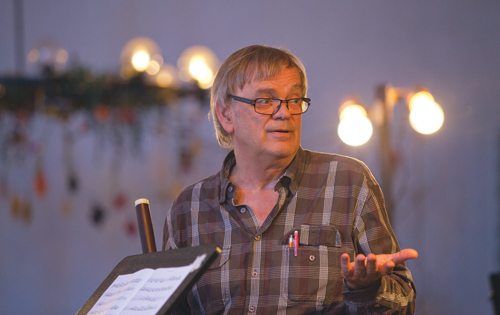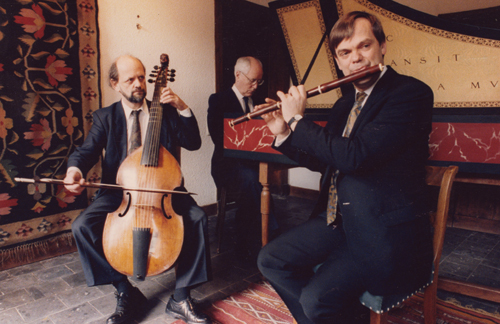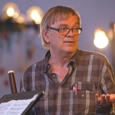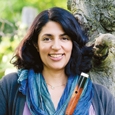
Barthold Kuijken is an eminent leader in the field of Early Music. A virtuoso traverso soloist, teacher, researcher, and conductor, he has shaped the fields of historical flutes and historically informed performance over the last 40 years. A Flemish native of Belgium, Kuijken has performed and recorded most of the repertoire for the Baroque flute. He has collaborated with other early music specialists including his brothers, Sigiswald Kuijken (violin) and Wieland Kuijken (cello and viola da gamba), Frans Brüggen, and harpsichordist Gustav Leonhardt. Kuijken is the Artistic Director and conductor of the Indianapolis Baroque Orchestra. He recently retired as Professor of Baroque Flute at the Royal Conservatories of Brussels and The Hague. In 2013, Kuijken received the NFA Lifetime Achievement Award.
You are widely regarded as a pioneer of Early Music. How did you become interested in playing the traverso?
Let me begin by saying that I don’t feel like a pioneer of Early Music. There were people who were doing these kinds of things, perhaps in a different way, long before me. I have been very active in the Early Music field and have taught many students in addition to making lots of recordings, but I am not a pioneer.
I grew up in a house in which music was a very natural part of life. During my childhood, my two older brothers, Wieland and Sigiswald, were already on their way to becoming professional musicians and making their first steps in Early Music. I heard my brothers practicing whenever I came home from school. We often played together whenever there was any free time. Being the youngest, I was just pointed to what part I should play. I learned to read music and to skip over things I couldn’t play, which was an excellent schooling in sightreading.
My brothers had a friend who would bring recordings over to our house. In those days, we had very few records of our own. The many hours spent listening to the early recordings of Deller, Wenzinger, Harnoncourt, Brüggen, and Leonhardt awakened our curiosity and made us hungry for more. However, living quite isolated in the small provincial town of Bruges, didn’t make things easier. Luckily, the Brussels Conservatory had a very rich musical instruments museum and a superb library. It is a real gold mine filled with old manuscripts, prints, treatises, and books.
For my 13th birthday, my brother Sigiswald gave me the facsimile of the Quantz treatise, which was of course in German and in Gothic print. German and Flemish are related languages, but probably not much more than German and English. The Gothic print was also kind of a problem, but I knew that my parents had a dictionary with those kinds of letters in their library. I just sat down in the evenings and tried to read it, learning German along the way. After a week or so, I must have finished the first page, which is the dedication, and of course not very informative. Reading Quantz, I started to realize that he must have been talking about another flute than my familiar Boehm instrument. This was then confirmed by seeing pictures and instruments at the museum. As luck had it, a friend of a friend had a traverso that I could try. Later, while in my first year of flute studies at the Brussels Royal Conservatory, I found a beautiful original traverso made in Brussels ca. 1750. This instrument was the best teacher I ever had.
Who were your main teachers?
I received a mainstream conservatory training on Boehm flute with Francis Stoefs at the Brussels Conservatory and went on to study with Frans Vester at the Royal Conservatory of the Hague. On the traverso, I had no formal teachers because there were simply none around. Of course I had lots of contact with my two older brothers who play cello, viola da gamba, and violin. I would also mention Alfred Deller, one of the first British countertenors. Although I never had lessons with him, I attended one or two of his masterclasses. The only thing that he really said, and kept saying in his most gentle voice was, “text please,” and that was it. No technical directions, sound exercises, or vocal exercises, just, “text please.” This statement has stayed with me. Alfred Deller was the first who made me aware of the fact that in vocal music, pronunciation is absolutely essential. Consequently, for us instrumentalists, having no text to guide us, articulation becomes even more of an issue. Cantabile without words (or without adequate replacement of text by elaborate articulation) makes no sense; it simply becomes la-la-la, however beautiful the la may be.
I am also immensely grateful to Gustav Leonhardt. He wouldn’t have ever agreed, but he has been a kind of mentor for me. I had the great fortune of frequently playing with him ever since I was a young musician until his very last year. I was always touched by his attitude of respect for music, taking notation seriously but not literally. Notation had to be decoded competently, with insight, and heartfelt. As a performer, he never aimed to push himself to the forefront. There was always a great sense of internal logic and consequence in what he did. I think he was probably one of the people who have marked me the most.

What led you to begin playing in Early Music ensembles?
From the late 1960s and early 1970s, I played quite a lot of concerts with my brothers and harpsichordist Robert Kohnen. In the beginning, we didn’t even have a name. We were called the Kuijken Ensemble or Kuijken Quartet. We toured a lot in the U.S. and Canada in the 1970s and 1980s. At the same time, I played in La Petite Bande, the chamber orchestra that my brother Sigiswald started in 1972. We first played many early French works (Lully and Rameau) and later extended to Bach, Handel, Haydn, and Mozart. From the early to late 1970s, I played in a German Early Music chamber orchestra, Collegium Aureum. We did some Baroque repertoire, but also a lot of Classical to early Romantic music. The last project was Beethoven’s Eroica on early instruments. That was quite an adventure. There was no conductor, just a very good concertmaster. Probably now, we would say that that group was stylistically about half way, but at least we were half way – the cup was half full!
Then there were the yearly passions and masses, which are a large part of musical life in Europe (like Handel’s Messiah in the U.S.). I was not familiar with church music initially because my family was not Christian, Jewish, or Muslim. We were just nothing, which was quite rare in those days in Flanders. Certainly in the small beautiful town of Bruges where we lived in the 50s and 60s, most people were Catholic. My first and best contacts with religion were the many visits to the great French Romanesque and Gothic cathedrals to look at the artwork. Even more strongly, playing Bach’s St. John Passion each year was a wonderful entrance into the religious atmosphere. I am still incredibly fond of that piece.
How would you describe the differences between modern flute and traverso?
I could say that traverso is exactly the same as modern flute, and everything is different. The principle of course is the same: traverso and modern flute are both flutes. You have an embouchure, finger holes, and a tube. That is about it, as far as how they are absolutely similar. Since the size of the embouchure hole is mostly much smaller, you need another breathing technique or breathing dimension. Since you don’t have all the keys of a modern flute, you need other fingerings. And then, the aesthetics are very different: the ultimate idea of the Baroque flute was not the strong, perfect, homogenous and brilliant sound of a modern flute, but rather a more individually colored scale and a vocal style. This requires a completely different playing technique.
We have always had the problem of whether evolution should be called progress. Certainly with the modern flute, you really gain in equality, homogeneity, volume, and ease, but maybe you lose the different colors and subtlety. You can’t have it all, I think. The moment that I perceive a certain piece of music needs more of the typical characteristics of an early flute, the modern flute gives me the feeling of having the wrong tool in my hands. I am certain that in many situations, a knife can replace a screwdriver, but I would always rather choose the tool that is asked to do that particular job. When a modern composer hears the word flute, he has a certain image in mind. When Couperin heard the word flute, he would have had a totally different image. We would immediately start laughing at the suggestion of playing the Prokofiev Sonata on traverso, but we don’t laugh when people play a Bach Sonata on modern flute – isn’t that strange. We will never know entirely what the exact right tool would be, but I would love to use the tool that the composer might have had in mind when he wrote the piece.
What advice do you have for modern flutists who are interested in playing traverso?
I would certainly start by getting a good instrument, at A = 415 Hz or lower, with a small round embouchure hole. Such instruments force you to adapt immediately a great deal, since they do not allow you to blow very hard. In most modern flute schools, there is a lot of blowing involved, and most of the early instruments don’t like that. Then I would work on getting the forked fingerings like F natural or A flat in the first octave to sound well and in tune. The forked fingerings will not work when you blow too strongly. I would not try to achieve volume in the beginning, but rather care for a very well-focused sound that allows you to quickly and easily change dynamics on any note. I would forget about vibrato (except the occasional finger vibrato). Never try to suppress vibrato: it will fight back. If we replace the shape that vibrato gives to a note by another conscious shape, such as a crescendo-diminuendo messa di voce, we easily forget vibrato.
I have always thought that the French repertoire (Hotteterre, de la Barre, Philidor, Blavet) is a very good starting point for learning to play the traverso. Beginning with French music is much better than Vivaldi, Handel, or Bach since it is written very idiomatically for the instrument and comes from these flutist-composers’ personal experience. I would also play music that has a text as often as possible. Provided you know the language, the text will give you all of the necessary cues about breathing, articulation, phrasing, dynamics, and mood. Of course, not all music has an English text, and in fact, there isn’t even that much Baroque music with an English text. Thus, along with studying French repertoire, I would say, learn French. When playing German or Italian music, learn German and Italian. I would feel very strange spending my life playing Chinese music without being able to speak Chinese! Every language has its own melody, harmony, and rhythm that are naturally reflected in the music. One should acquire an intimate knowledge of those languages. Just understanding it passively is really not enough. I need to get the feel of it, learn to really read and speak it, and know its vocabulary, grammar, and syntax. That’s a lot of work, but there really is no other option.
The arts are a huge and incredibly rich field. If I want to understand the music of a certain period it is not a bad idea to study the other art forms of that same time, be it literature, dancing, painting, sculpture, or whatever. Those are very important points of information and comparison. If you are studying French Baroque music, looking at French paintings from time of Louis XIV gives you an idea of how people were dressed, how they would move, and what kind of landscape they had in their fantasy. Music is just one little slice of art. To understand it, see the whole loaf of bread, and not just one slice.
How do you approach a new piece?
I love to study a piece without the instrument. Just sit in an easy chair and let the piece come into you in the same way that you would do with a piece of poetry. Read it, and read it again, and read it again, and let it come in. Then start all over, reading it until the sound result of the piece becomes very clear in your mind. It is important to have a crystal clear idea of what you want to say before opening your mouth. I really feel that once we know what we want to hear, or rather need to hear, in every detail, the piece is basically practiced. With a good technique, you can do it, or you will easily find a technique enabling you to create that inner image. In other words, work backward from the imagined artistic result to the technical problems that may occur, but not vice versa. Starting with the technical problem might bring you towards a technical solution, but not necessarily towards art.
When we play music that somebody else composed, we kind of handle someone else’s property, and I want to do that with respect. As a performer, I think that in the first place it is about the piece. I have the role of a translator or a messenger. Most people in the audience cannot read music, so they need somebody to play it for them. I do not want to pull the whole thing toward me and say, “Good old Bach is dead and buried, so I will play it the way I want on the instrument I want.” Of course, if somebody wants to do that, he or she should. However, I think it’s a bit unfair towards the composer. Try to understand what the composers wrote, notice how fast ideas change, how fast fashions change, and how fast technique changes. Try to figure out how people in earlier times decoded notation. This way of studying takes a while, but it’s very fruitful.
I had been busy with the idea of decoding early notation ever since I read Quantz. I noticed that he writes music and then tells you in his book what you should add during performance, even though nobody would have ever cared to notate it. This was the opposite of my conservatory experience. We were expected to play exactly what was written and not dare to add a note or change a dynamic. I think that it was very healthy that I was already confronted with this dilemma at an early age: was I going to follow modern notation reading technique of playing only what’s on the page, or was I going to follow the notation decoding that I learned in treatises like Quantz and others. It became obvious to me that the second answer was the right one. Why should I play Quantz using notation reading techniques that are appropriate for the music of Boulez? Vice versa, if I would treat the Boulez Sonatine as if it were a Bach or Quantz sonata (adding ornaments, dynamics, and articulations), you would laugh and say you can’t do that. If I reverse the argument, I would say that you can’t do that – playing literally only what is written on the page – to a Telemann or Bach sonata either. When we see how everything in life (and in music) changes, wouldn’t it be strange if we should apply the same decoding conventions for all music from all times? It is very interesting to see how the encoding and decoding of pitch, tempo, rhythm, phrasing, articulation, dynamics, ornamentation, and instrumentation change with place and time. It is like learning to read through the composers’ glasses. That was the starting point that ultimately led to my book, The Notation Is Not the Music. This book is not an Early Music method book. I rather wanted to reflect on the underlying ideas and principles that could guide us when performing earlier repertoire.
How do you see the role of a teacher?
As a teacher, we should make ourselves superfluous. We have to teach students to become autodidacts. Asking questions rather than giving solutions is the key. I always want to help students to find their own voices, to master the instrument with lots of love, understanding and respect for it, and without being rough to it, despising it, or being afraid of it. Let the flute sound; don’t make it sound. In teaching, I try to see who the student is, what his or her possibilities, sensitivities, language, and mood are, and from there try to wake up curiosity. I deem myself very lucky that as a traverso player, I have had no teacher. I had the incredible luck as a boy of 18 to get a wonderful original mid-18th century flute by the Brussels maker, Godefroy Adrien Rottenburgh. Such a splendid instrument tells you how to play, or maybe rather how not to play it. If you try to force it, for instance, it gently tells you, please don’t. It was the best teacher I ever had. Without a real teacher, I had to find out for myself what worked, master the instrument, search for repertoire, and discover my voice. I had to teach myself, based on the instructions that the instruments themselves and the accompanying treatises (not only for flute) could give me. I also had to digest the many bits and pieces of information that come from the music itself and from the wider context. This was a slow way to learn, certainly. I had to make all mistakes by myself, and eventually find out that and why they were mistakes. In this way, however, your choices are not polluted by the experiences or theories of a teacher who would tell you which way to go or not to go.
I have hoped to find and tried to provoke a similar attitude in my students. I have absolutely no pretention of leading anyone in the only right way. I don’t feel like a kind of missionary flutist who has to spread the good word. I can only say what I have to say, starting from my own experience and my artistic integrity. If somebody does not want to listen, that is ok. Any student’s arguments are as good as mine – that is, if they are solid, well-documented, and well-developed. Let students read, listen, study, and think for themselves. Let them shape their own imagination. If you don’t want to fossilize, you have to continue learning on your own.
How has the field of Early Music changed over your lifetime and what direction do you think that it might take next?
If I would have a wish for future change, it would be that more people would stay curious or become curious again, and not base themselves too much on the results of previous generations. When I started to be seriously active in Early Music, the quality of the instruments was not as good as today. The technical level of performance is also much more polished than it used to be. There was not so much information available yet. There were maybe three or four flute treatises that you could find and buy a copy of. Now there are probably 400 available (also thanks to the Internet). There is so much available that, unfortunately, many people become discouraged and do not even start searching.
I would be the first person to say that I have no idea how the Baroque flute should be played. I have my ideas, based on how I have digested the information that I could find, but I am quite certain that I would be very much astonished if I could hear the sound and style of Hotteterre, Blavet, Quantz, Devienne, Nicholson, Fürstenau, Boehm or even Taffanel. I am totally aware of the fact that I will never play like Bach played and that I cannot really know how he played, but that does not mean that I can’t try to move into his direction, rather than further away from him. In other words, the path is more interesting than the goal.
Historical recordings document how flute playing has changed over the past 100 years. For the more remote past, we have to extrapolate and reconstruct sound from artifacts such as instruments, compositions, books, and paintings. For me, exactly that kind of questioning curiosity is the important drive behind all of it. Ignoring questions is not an option, and searching became second nature. When you start searching, you never know what you are going to find. It might be quite different from what you sought or thought you might find. It’s a nice adventure.
* * *
What are your thoughts on conducting?
I feel incredibly lucky that I have been asked to conduct many projects over the last 25-30 years. I have great pleasure in doing it, but I am not so ambitious as to declare myself a conductor. I would say that I am a musician. In the end, it is all very much the same. When you play a piece of music on the flute, you have to know what you want and use your flute as your medium. With an orchestra I must also try to get the sound I had imagined in my mind. Just as I need to respect the character of the flute that I am playing, I have to respect the qualities and individualities of the players in an orchestra.
I have been working together with the Indianapolis Baroque Orchestra as conductor and artistic director for quite a number of years. A few years ago, the idea came to make a series of recordings with the orchestra. For many years, I had the desire to realize an idea I had about the orchestral music of Lully and his followers. I always felt so strange when I looked at Lully’s instrumental music or heard recordings of it. The music seemed so simple, empty, and even a bit drab. It didn’t make sense to me that this kind of music took Europe by storm to the point that every prince in Germany, England, and even some in Italy wanted to have played it at his court.
We are lucky that one of Lully’s students, Georg Muffat, explained in great detail just how this music should be played, which bowings should be taken, how the rhythms should be read, and which ornaments must be added even if unwritten. We find the same ornamentation in the splendid harpsichord arrangement of the Passacaille in Lully’s opera Armide; the transcriber is d’Anglebert, a younger contemporary of Lully’s. In fact, in Lully’s or Muffat’s time, any well-trained professional musician would have known where and how to add ornaments in his part; it was not necessary to notate them.
As this tradition is mostly lost today, I decided to add that whole layer of articulation and ornamentation in each section of the orchestra. Hearing the results, it became obvious to me why everyone was so enthusiastic about Lully’s music. After making two CD recordings in this way (the second is to be released this summer or autumn), it is absolutely clear to me that we are on a very good track.






